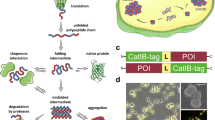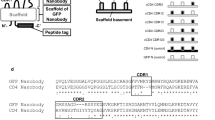Abstract
Nanobodies are stable molecules that can often fold correctly even in the absence of the disulfide bond(s) that stabilize their three-dimensional conformation. Nevertheless, some nanobodies require the formation of disulfide bonds, and therefore they are commonly expressed from vectors that promote their secretion into the oxidizing environment of the Escherichia coli periplasm. As an alternative, the bacterial cytoplasm can be an effective compartment for producing correctly folded nanobodies when sulfhydryl oxidase and disulfide-bond isomerase activities are co-expressed from a recombinant vector. The larger volume and wider chaperone/foldase availability of the cytoplasm enable the achievement of high yields of both nanobodies and nanobody-tag fusions, independently of their redox requirements. Among other examples, the protocol described here was used to successfully produce nanobody fusions with fluorescent proteins that do not fold correctly in the periplasm, nanobodies with Fc domains, and nanobodies containing free cysteine tags.
Access this chapter
Tax calculation will be finalised at checkout
Purchases are for personal use only
Similar content being viewed by others
References
Bradbury A, Plückthun A (2015) Reproducibility: standardize antibodies used in research. Nature 518:27–29
de Marco A (2015) Recombinant antibody production evolves into multiple options aimed at yielding reagents suitable for application-specific needs. Microb Cell Fact 14:125
Veggiani G, Giabbai B, Semrau MS et al (2020) Comparative analysis of fusion tags used to functionalize recombinant antibodies. Protein Expr Purif 166:105505
de Marco A (2020) Recombinant expression of nanobodies and nanobody-derived immunoreagents. Protein Expr Purif 172:105645
Traenkle B, Rothbauer U (2017) Under the microscope: single-domain antibodies for live-cell imaging and super-resolution microscopy. Front Immunol 8:1030
Cramer K, Bolender AL, Stockmar I et al (2019) Visualization of bacterial protein complexes labeled with fluorescent proteins and nanobody binders for STED microscopy. Int J Mol Sci 20:3376
Virant D, Traenkle B, Maier J et al (2018) A peptide tag-specific nanobody enables high-quality labeling for dSTORM imaging. Nat Commun 9:930
De Tavernier E, Detalle L, Morizzo E et al (2016) High throughput combinatorial formatting of PcrV nanobodies for efficient potency improvement. J Biol Chem 291:15243–15255
Vaidyanathan G, McDougald D, Choi J et al (2016) Preclinical evaluation of 18F-labeled anti-HER2 nanobody conjugates for imaging HER2 receptor expression by immuno-PET. J Nucl Med 57:967–973
Krüwel T, Nevoltris D, Bode J et al (2016) In vivo detection of small tumour lesions by multi-pinhole SPECT applying a 99mTc-labelled nanobody targeting the epidermal growth factor receptor. Sci Rep 6:21834
Soler MA, Medagli B, Semrau MS et al (2019) A consensus protocol for the in silico optimisation of antibody fragments. Chem Commun 55:14043–14046
Henry KA, Sulea T, van Faassen H et al (2016) A rational engineering strategy for designing protein A-binding camelid single-domain antibodies. PLoS One 11:e0163113
Henry KA, Tanha J, Hussack G (2015) Identification of cross-reactive single-domain antibodies against serum albumin using next-generation DNA sequencing. Protein Eng Des Sel 28:379–383
Nguyen VD, Hatahet F, Salo KE et al (2011) Pre-expression of a sulfhydryl oxidase significantly increases the yields of eukaryotic disulfide bond containing proteins expressed in the cytoplasm of E. coli. Microb Cell Fact 10:1
Veggiani G, de Marco A (2011) Improved quantitative and qualitative production of single-domain intrabodies mediated by the co-expression of Erv1p sulfhydryl oxidase. Protein Expr Purif 79:111–114
Bessette PH, Aslund F, Beckwith J et al (1999) Efficient folding of proteins with multiple disulfide bonds in the Escherichia coli cytoplasm. Proc Natl Acad Sci U S A 96:13703–13708
Meiresonne NY, Consoli E, Mertens LMY et al (2019) Superfolder mTurquoise2ox optimized for the bacterial periplasm allows high efficiency in vivo FRET of cell division antibiotic targets. Mol Microbiol 111:1025–1038
Djender S, Schneider A, Beugnet A et al (2014) Bacterial cytoplasm as an effective cell compartment for producing functional VHH-based affinity reagents and Camelidae IgG-like recombinant antibodies. Microb Cell Fact 13:140
Ambrosetti E, Paoletti P, Bosco A et al (2017) Quantification of circulating cancer biomarkers via sensitive topographic measurements on single binder nanoarrays. ACS Omega 2:2618–2629
Bernardinelli G, Oloketuyi S, Werner SF et al (2020) A compact nanobody-DNAzyme conjugate enables antigen detection and signal amplification. New Biotechnol 56:1–8
Oloketuyi S, Mazzega E, Zavašnik J et al (2020) Electrochemical immunosensor functionalized with nanobodies for the detection of the toxic microalgae Alexandrium minutum using glassy carbon electrode modified with gold nanoparticles. Biosens Bioelectron 54:112052
de Marco A (2007) Protocol for preparing proteins with improved solubility by co-expression with molecular chaperones in Escherichia coli. Nat Protocols 2:2632–2639
de Marco A, Berrow N, Lebendiker M, Garcia-Alai M, Knauer SH, Lopez-Mendez B, Matagne A, Parret A, Remans K, Uebel S, Raynal B (2021) Quality control of protein reagents for the improvement of research data reproducibility. Nat Commun 12(1):2795
Capasso P, Aliprandi M, Ossolengo G et al (2009) Monodispersity of recombinant Cre recombinase correlates with its effectiveness in vivo. BMC Biotechnol 9:80
Glasel JA (1995) Validity of nucleic acid purities monitored by 260nm/280nm absorbance ratios. Biotechniques 18:62–63
Author information
Authors and Affiliations
Corresponding author
Editor information
Editors and Affiliations
Rights and permissions
Copyright information
© 2022 The Author(s), under exclusive license to Springer Science+Business Media, LLC, part of Springer Nature
About this protocol
Cite this protocol
de Marco, A. (2022). Cytoplasmic Production of Nanobodies and Nanobody-Based Reagents by Co-Expression of Sulfhydryl Oxidase and DsbC Isomerase. In: Hussack, G., Henry, K.A. (eds) Single-Domain Antibodies. Methods in Molecular Biology, vol 2446. Humana, New York, NY. https://doi.org/10.1007/978-1-0716-2075-5_7
Download citation
DOI: https://doi.org/10.1007/978-1-0716-2075-5_7
Published:
Publisher Name: Humana, New York, NY
Print ISBN: 978-1-0716-2074-8
Online ISBN: 978-1-0716-2075-5
eBook Packages: Springer Protocols




